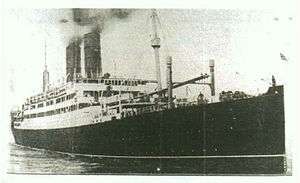SS Tuscania (1914)
 SS Tuscania | |
| History | |
|---|---|
| Owner: | Anchor Line |
| Builder: | Alexander Stephen & Sons, Ltd., Linthouse, Govan |
| Laid down: | 1914 |
| Launched: | September 1914 |
| Fate: | Sunk 5 February 1918 |
| General characteristics | |
| Tonnage: | 14,348 gross tons |
| Length: | 567 ft (173 m) |
| Beam: | 66 ft 4 in (20.22 m) |
| Draught: | 45 ft (14 m) |
| Propulsion: | Parsons steam turbines - twin screw[1] |
| Capacity: | 2,500+ passengers |
| Armament: | 4-inch naval gun (fitted October 1916)[2] |
SS Tuscania was a luxury liner of the Cunard Line subsidiary Anchor Line, named after Tuscania, Italy. She was torpedoed in 1918 by the German U-boat UB-77 while transporting American troops to Europe and sank, sending 210 people to their deaths.[3]
Operations
Tuscania carried passengers between New York City and Glasgow while in service with the Anchor Line, on a route that had previously been assigned to her sister ship Transylvania.[1] She continued to run this route even as World War I broke out in Europe in August 1914 and Germany initiated a submarine campaign against merchant shipping in waters near the United Kingdom. She also made at least one run from Bombay to Liverpool.
Tuscania made international headlines for rescuing passengers and crew from the burning Greek steamer SS Athinai on 20 September 1915,[4] In 1916, was refitted and pressed into service as a troopship. She made the news again in March 1917 by evading a submarine and a suspected Imperial German Navy armed merchant cruiser.[5]
Final voyage
On 24 January 1918, Tuscania departed Hoboken, New Jersey, with 384 crew members and 2,013 United States Army personnel aboard. On the morning of 5 February 5 1918, she turned south for the North Channel en route Liverpool. The German submarine UB-77 sighted Tuscania′s convoy during the day and stalked it until early evening. Under the cover of darkness at about 6:40 p.m., the submarine′s commanding officer, Korvettenkapitän Wilhelm Meyer, ordered two torpedoes fired at Tuscania. The second of these struck home, sending her to the bottom of the Irish Sea within about four hours. Tuscanbia sank nearly three years to the day after her maiden voyage as a passenger liner. Approximately 210 of the troops and crew were lost,[3] while many others were rescued by the Royal Navy destroyers Mosquito and Pigeon.[6]
The wreck of Tuscania lies between Scotland's Islay and Northern Ireland′s Rathlin Island, about 7 nautical miles (13 km) north of Rathlin lighthouse, at roughly 55°24′36″N 6°11′06″W / 55.41°N 06.185°W under 100 meters (328 feet()of water.
Notable passengers
- Harry Randall Truman, who later died in the 1980 eruption of Mount St. Helens
- Sydney Brooks, British critic (survived sinking)[7][8]
- Leonard Read, founder of Foundation for Economic Education (survived sinking)
Army units on board
- 100th Aero Squadron
- 158th Aero Squadron
- 213th Aero Squadron
- 32nd Infantry Division (United States)
- 20th Engineers
- 357th Infantry
- 165th Depot
References
- 1 2 "Tuscania Was Pride of the Anchor Line" New York Times 07 Feb 1918: p. 2
- ↑ "Tuscania Carried No Civil Passengers" New York Times 07 Feb 1918: p. 2
- 1 2 Massie, Robert K. Castles of Steel: Britain, Germany, and the Winning of the Great War at Sea. New York: Ballantine Books, 2004. ISBN 0-345-40878-0
- ↑ "Greek Liner Burns at Sea, 469 saved," The Philadelphia Inquirer, 21 September 1915, p. 2.
- ↑ "Report the Tuscania Dodged a Submarine", The New York Times, 22 March 1917, p.3
- ↑ "Troopship Tuscania Oa Peninsula Islay|Loss of Troopship Tuscania". Islayinfo.com. Retrieved 2012-12-14.
- ↑ Wikisource:Author:Sydney Brooks
- ↑ "Britain's Heart Now of Granite" The New York Times, January 19, 1916: p.2
External links
- Tuscania, an American History
- 100th Aero Squadron - History(subscription required)
- 158th Aero Squadron - History(subscription required)
- 213th Aero Squadron - History(subscription required)
- Collection of Tuscania related photographs
Coordinates: 55°37′N 6°26′W / 55.617°N 6.433°W